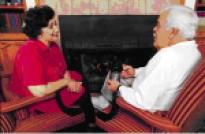 This is a question I recently received:
This is a question I recently received:
Hello Beth.
I notice that the monthly costs for my reverse mortgage loan include very costly mortgage insurance. From my experience as a homeowner, mortgage insurance was to cover the mortgage payment in the event the mortgagee could not make payments for one reason or the other. Since there are no mortgage payments in a reverse mortgage loan, why do I have to pay mortgage insurance?
Thank you.
This is a very good question!
With conventional mortgages many people look at mortgage insurance premiums as protection of risk if they, the borrowers, can’t make their monthly mortgage payments. The reverse mortgage doesn’t have monthly mortgage payments required for this product. Although with the reverse mortgage there is a repayment required, it is one payment when the loan becomes due and payable, generally when the borrower(s) is(are) no longer in the home as their primary residence.
Mortgage insurance on a reverse mortgage does not protect the consumer or borrowers obligation to pay the loan balance when the home is no longer the primary residence of the borrower or if they haven’t abided by the terms of the loan.
However, with a Federal Housing Administration (FHA) insured Home Equity Conversion Mortgage or better known as a HECM reverse mortgage, there is a required mortgage insurance premium by FHA. The FHA Mortgage Insurance Premiums (MIP) offer significant benefits for reverse mortgage lenders, investors, as well as the borrowers.
The FHA required MIP are in place even though one is not making mortgage payments for several reasons:
- The insurance protects the investors against risk and loss.
There are also advantages and increased borrowing power for the borrowers with FHA insuring the reverse mortgage. These include:
- Guaranteeing the funds are available for you, the borrower, during the term of the loan. With HELOCs the bank/lender can call the loan due and payable if there are changes with the bank, for example they merge with another bank/lender or they close their doors.
- Guaranteeing the reverse mortgage lender against default or shortfalls means the interest rates are lower compared to other mortgages for the benefits one receives with the reverse mortgage. i.e.,
- With conventional loans the interest is impacted by one’s credit score. With the reverse mortgage one’s credit, even if it’s poor, does not impact the interest rate.
- The FHA insurance on the HECM loans keep the interest rate low and allows more dollars to be loaned than with proprietary programs. Proprietary reverse mortgage programs have a higher interest rate to cover the lender’s and investor’s risks and loss.
- Providing a line of credit growth rate (available only with reverse mortgages). The tenure monthly payment option also has a growth rate factored in when the tenure payment is calculated.
- As a reverse mortgage it is a non-recourse (no personal liability) loan. What this means is if the loan balance on the reverse mortgage is higher than what the fair market value is on the home when the loan is due and payable, the FHA MIP will cover the difference to the lender rather than the borrowers or their heirs having to come up with the difference.
If you are considering a reverse mortgage, look at the benefits of the reverse mortgage which include:
- No monthly mortgage payments, therefore increase your cash flow.
- With no monthly mortgage payments required the risk of default due to not being able to make monthly mortgage payments is reduced. (Borrowers are still required to pay property taxes, keep hazard insurance on and maintain the property and pay home owners association dues if applicable.)
- A line of credit option which has a growth rate making more funds available to you in the future, no other mortgage offers this. Or you can use the funds to receive monthly payments either as tenure (life of the loan) or an amount set by you.
- Non-recourse, no personal liability to you or your heirs.
While there have been different structures for calculating the MIP with past programs, currently, the up-front FHA MIP is .5% of the property value or mortgage lending limit, whichever is less if borrowing 60% or less of the Principal Limit within the 1st 12 months; 2.5% if borrowing more than 60% of the Principal Limit within the 1st 12 months. The on-going MIP is 1.25% of the loan balance.
 To summarize, while one is not making payments on their reverse mortgage, the FHA Mortgage Insurance Premium with the reverse mortgage provides benefits over conventional and HELOCs where mortgage payments are required, which cannot be received with any other mortgage.
To summarize, while one is not making payments on their reverse mortgage, the FHA Mortgage Insurance Premium with the reverse mortgage provides benefits over conventional and HELOCs where mortgage payments are required, which cannot be received with any other mortgage.
For further details on the reverse mortgage contact us if you are in Minnesota. As your local broker, we work with several lenders and provide free information and facts with no obligation, meeting in person whenever possible. For other states, contact your local reverse mortgage specialist who is a broker, one who works with several lenders, has their Broker License/NMLS and preferably holds the Certified Reverse Mortgage Professional (CRMP) designation.
© 2016 Beth Paterson, CRMP, Beth’s Reverse Mortgage Blog, 651-762-9648
This material may be re-posted provided it is re-posted in its entirety and without modifications and includes the contact information, copyright information and the following link: http://wp.me/p4EUZQ-1oM
Related Articles:
- Reverse Mortgage Features and Terms Summary
- Seventeen Facts About Reverse Mortgages You May Not Know
- Minnesota Reverse Mortgage Costs
- Surprise! Reverse Mortgage Closing Costs Actually Compare to Conventional Mortgage Costs
- Basics of Reverse Mortgages You Need To Know
- Let Me Educate You On Adjustable Rate Reverse Mortgages
- Reverse Mortgages Give Reason for Hope
- Reverse Mortgage Assists to Cover Expenses and Protect Assets
Blog posts’ information is current as of date post published, program is subject to change in in the future. Contact us for current information, 651-762-9648.
This site or the information provided is not from, or approved by, HUD, FHA, or any US Government or Agency.

 Often stated, the reverse mortgage is expensive and the fee the originator makes is part of the reason. Originating reverse mortgages is not as easy as one, two, three but a very time consuming process whether one is a retail officer (works directly for the lender) or a broker (one who works with various lenders). Note that brokers are often more involved in the process, not just taking an application and moving on to the next application.
Often stated, the reverse mortgage is expensive and the fee the originator makes is part of the reason. Originating reverse mortgages is not as easy as one, two, three but a very time consuming process whether one is a retail officer (works directly for the lender) or a broker (one who works with various lenders). Note that brokers are often more involved in the process, not just taking an application and moving on to the next application.






 An all too common statement is that a drawback of the reverse mortgage is the hefty or high up front fees. But are they really hefty? Are the fees really a drawback?
An all too common statement is that a drawback of the reverse mortgage is the hefty or high up front fees. But are they really hefty? Are the fees really a drawback?




 Often stated, the reverse mortgage is expensive and the fee the originator makes is part of the reason. Originating reverse mortgages is not as easy as one, two, three but a very time consuming process.
Often stated, the reverse mortgage is expensive and the fee the originator makes is part of the reason. Originating reverse mortgages is not as easy as one, two, three but a very time consuming process.
